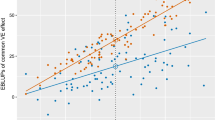Summary
The expected response of a population of competing genotypes to selection of high yielding individuals is expressed in terms of a regression model of a type similar to that used to describe genotype-environment interactions (Perkins and Jinks 1968). It is shown that response to selection on the basis of the yielding ability of genotypes (direct effects) can also cause changes in the magnitude of their effects on their neighbours (indirect effects) and on the interactions of direct and indirect effects. Thus, if yij = μ + gi aj + γjgi + sij, where yij is the expected yield of the ith genotype in competition with the jth, gi is the direct effect of the ith genotype, aj the indirect effect of the jth, and γj the regression onto direct effects of interactions involving the jth associate, it follows that response is R(g) = g(1+b(a/g) + bγ/gg), where g is the change in average direct effect of the population brought about by selection, and b represents a regression coefficient. If b(γ/g) is important, then response to selection will be non-linear over a range of genotypes, and where it is negative, then selection will become progressively less effective as it proceeds until a plateau is reached, beyond which it will be detrimental.
Estimates of the above parameters were made from nine sets of data from diallel arrangements of binary mixtures. Although a degree of uncertainly was induced in these estimates by the need to reparametrize the model describing competition within and between binary components to cater only for inter-genotypic effects, the consistency of the prediction of non-linearity of response induces some confidence in the results. Predicted optima are as low as 8 pc abovethe mean inthe case of closely related material. Other deficiencies and implications of this selection model are discussed.
Similar content being viewed by others
Literature
Breese, E.L.; Hill, J.: Regression analysis of interactions between competing species. Heredity 31, 181–200 (1973)
Eberhart, S.A.; Russell, W.A.: Stability parameters for comparing varieties. Crop Sci. 6, 36–40 (1966)
England, F.E.: Competition in mixtures of herbage grasses. J. appl. Ecol. 5, 227–242 (1968)
Finlay, K.W.; Wilkinson, G.N.: The analysis of adaption in a plant breeding programme. Austr. J. agric. Res. 14, 742–754 (1963)
Gallais, A.: Sur quelques aspects de la compétition en amélioration des plantes. Ann. Amélior. Plantes 25, 51–64 (1975)
Griffing, B.: Selection in reference to biological groups. I. Individual and group selection applied to populations of unordered groups. Austr. J. Biol. Sci. 20, 127–139 (1967)
Hill, J.: Methods of analysing competition with special reference to herbage plants. II. Effects of associate plants. J. agric. Sci. Camb. 81, 91–98 (1973)
Hill, J.: Methods of analysing competition with special reference to herbage plants. III. Monocultures v. binary mixtures. J. agric. Sci. Camb. 83, 57–65 (1974)
Jacquard, P.; Caputa, J.: Comparaison de trois modèles d'analyse des relations sociales entre especes végétales. Ann. Amelior. Plantes 20, 115–158 (1970)
Moav, R.; Wohlfarth, G.H.: Magnification through competition of genetic differences in Carp. Heredity 33, 181–202 (1974)
Norrington-Davies, J.: Diallel analysis of competition between grass species. J. agric. Sci. 71, 223–231 (1968)
Norrington-Davies, J.; Crowley, J.G.: Effect of density and fertility on the competitive interactions of diploid and tetraploid ryegrass during early growth. Ir. J. agric. Res. 8, 359–374 (1969)
Perkins, J.M.; Jinks, J.L.: Environmental and genotype-environmental components of variability. IV. Non-linear interactions for multiple inbred lines. Heredity 23, 525–535 (1968)
Utz, H.F.: Die Zerlegung der Genotyp X Umwelt-Interaktionen. EDV in Medizin und Biologie 2, 52–59 (1972)
Willey, R.W.; Heath, S.B.: The quantitative relationships between population and crop yield. Adv. in Agronomy 21, 281–321 (1969)
Williams, E.J.: The analysis of competition experiments. Aust. J. Biol. Sci. 15, 509–525 (1962)
Wright, A.J.: The analysis and prediction of some two factor interactions in grass breeding. J. agric. Sci. Camb. 76, 301–306 (1971)
Author information
Authors and Affiliations
Additional information
Communicated by R. Riley
Rights and permissions
About this article
Cite this article
Wright, A.J. Predictions of non-linear responses to selection for forage yield under competition. Theoret. Appl. Genetics 49, 201–207 (1977). https://doi.org/10.1007/BF00274474
Received:
Issue Date:
DOI: https://doi.org/10.1007/BF00274474




